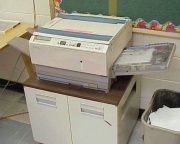Xerography
Description
A dry, electrostatic method for photocopying text or graphics. In one process, an image of the material to be copied is projected onto a substrate, such as a sheet of paper or a piece of fabric. This produces regions of static charge that selectively attract finely-divided, charged particles called photoconductive toner which is composed of a pigmented powder in a synthetic resin. The image is fixed by fusing the toner to the substrate with a few seconds of high heat. Black and white as well as color prints are possible using this method. Although Lichtenberg first made recordings by electrostatic means in 1777, the process for copying images by the electrophotographic process was developed by Charles F. Carlson was not developed until 1938. Commercial development of the process in the 1960s by a company called Xerox® resulted in synonymous association of their name with the photocopy process. Later, in the 1970s, the Xerox® process was used to capture images generated with an x-ray source.
See also Xeroradiography.
Synonyms and Related Terms
Xerox® [Xerox Corp.]; photocopy; electrofax; electrostatic; electrophotography; magnetography; electrography; elektrostatisch kopieerprocédé (Ned.); xérographie (Fr.); elektrostatisches Kopierverfahren (Deut.); Xerografia (It., Esp.); Procedimiento electroestático (Esp.); fotokopiering (Sven.); xerox (Sven.); Xerografi (Dan.)
Resources and Citations
- Website: "The invention no one ever wanted" at http://members.tripod.com/~earthdude1/xerox/index.html
- The Dictionary of Art, Grove's Dictionaries Inc., New York, 1996 Comment: "Electrography'
- Wikipedia: http://en.wikipedia.org/wiki/Photocopy (Accessed Nov. 9, 2005)
- G.G. Hawley, The Condensed Chemical Dictionary, Reinhold Publishing, New York, 6th ed., 1961
- The American Heritage Dictionary or Encarta, via Microsoft Bookshelf 98, Microsoft Corp., 1998
- Multilingual Glossary for Art Librarians at http://www.ifla.org/VII/s30/pub/mgl.htm

